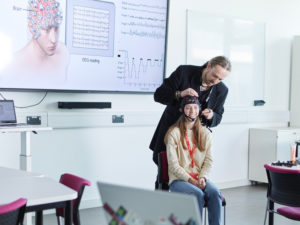Health and wellbeing
- Home
- Research
- Research Impact Showcase
- Health and wellbeing
Read about our Health and Wellbeing Research Impact Case Studies below.
-
REF Impact Case Study 2021
- Submitted to: 5 – Biological Sciences
- Submitted title: Changing the Media Narrative and Public Understanding of the Beneficial Effects of Stretching

Summary
Professor Tony Kay’s research have provided a new evidence base for the efficacy of stretching and its impact on performance and injury risk. Broad public dissemination to international media (the BBC, New York Times, and the Guardian), athletic governing bodies (Canadian Society of Exercise Physiology, American National Academy of Sports Medicine) and health bodies (NHS), has promoted the positive impact of stretching and Kay’s research has resulted in national and international health care bodies’ best practice recommendations ensuring stretching is used in warm–up routines.
The research findings are based on analysis of neurological, neuromuscular and the mechanical properties of whole muscle and tendon structures following various types of stretching. Kay has also demonstrated the most effective type of stretching is proprioceptive neuromuscular facilitation stretching which results in greater increases in the range of movement. Kay has examined stretch mechanisms, developed novel forms of stretching and identified common misconceptions on the impact of stretch on performance and injury risk.
Researchers
-
REF Impact Case Study 2021
- Submitted to: 5 – Biological Sciences
- Submitted title: Improving rehabilitation and advances in international practice in relation to ankle ligament surgical repair
Summary
Professor William Ribbans, a clinical practitioner (orthopaedic surgeon) and Professor of Sports Medicine, has developed innovative clinical practice and research establishing the effectiveness of the InternalBrace (a product developed for the treatment of ankle soft tissue injuries). For many surgeons around the world, the InternalBrace has become the primary method of ankle ligament stabilisation for all patients. This research has demonstrated that the use of the product can be extended beyond ankle treatment to a range of joints in the body with enhanced recovery, stability, and a quicker return to physical activity.
Based on over 20 years of research on the underlying pathologies of ankle and foot injuries, Professor Ribbans, focussed on investigating ways to secure better outcomes for ankle ligament surgery. With the launch of the InternalBrace in 2012 (originally developed by Professor Gordon Mackay), data has been used to confirm its efficacy in clinical treatment. Working with Professor Mackay, Ribbans has demonstrated that the surgical technique works, and this has been demonstrated in hands-on large educational cadaver workshop settings with Arthrex (the manufacturer of the InternalBrace), attended by medical professionals from surgical societies from the United Kingdom, Poland, Norway, Sweden, Denmark, and Finland. Ribbans has also spoken at international meetings held in Germany, Spain, Portugal, France, and the United Kingdom ensuring the adoption of the InternalBrace as an accepted technique by surgeons globally to improve patient outcomes.
Researchers
-
REF Impact Case Study 2021
- Submitted to: 2 – Public Health, Health Services and Primary Care
- Submitted title: Improving Social Cohesion, Wellbeing and Quality of Life through Lifelong Learning Models for People with Dementia and their Carers

Summary
Research undertaken by the University of Northampton’s Dementia Research and Innovation Centre (NDRIC) has led to the design and implementation of community-based post-diagnostic interventions for those with dementia and their caregivers. Led by Professor Jackie Parkes, this research has prioritised the voices of those living with dementia to develop, design and implement innovative approaches to person-centred community care and support.
The work of NDRIC has led to new local and regional support groups working to ensure people with dementia and their carers live well for longer at home. In collaboration with the Danish lifelong learning service, the Lifelong Learning Model has been introduced into the UK demonstrating the impact of the model on cognition, quality of life and socialisation for people with dementia. The research demonstrates how people in early-stage dementia can gain in confidence and in some cases acquire new skills via active engagement in cognitively stimulating activities, social support groups, and life-long learning opportunities, thereby enhancing their quality of life.
Researchers
-
REF Impact Case Study 2021
- Submitted to: 4 – Psychology, Psychiatry and Neuroscience
- Submitted title: Wellbeing benefits of enabling a non-academic audience to make sense of anomalous experiences by providing a science-based understanding

Summary
Professor Chris Roe, Dr Callum Cooper, Dr Rachel Evenden and Dr Elizabeth Roxburgh have undertaken research that explores the significance of ‘paranormal’, ‘spiritual’ or ‘psychic’ (anomalous experiences) beliefs among the public. These experiences are often poorly understood and difficult for individuals to make sense of. Roxburgh and Evenden have shown that when people attempt to disclose these experiences they were often trivialised and treated as inauthentic and inappropriate for therapeutic purposes.
The research demonstrated that people who have AEs or after-death communication experiences typically regard them as important, meaningful events and when they are taken seriously and valued by others, experiencers can derive psychological benefit from processing them in ways that enable personal reflection and growth. Through collaboration with the Spiritualist National Union, this research has led to a practitioner community where members of the public can critically reflect on their own experiences and the attributions they make to them. For example, Cooper, Roe and Mitchell found that ostensible after-death communication experiences during bereavement could facilitate the bereavement process and foster feelings of hope for the future.
Researchers
- Professor Chris Roe
- Dr Callum Cooper
- Dr Rachel Evenden
- Dr Elizabeth Roxburgh
-
REF Impact Case Study 2021
- Submitted to: 2 – Public Health, Health Services and Primary Care
- Submitted title: Creating new public health tools and guidance regarding acute illness in young children

Summary
A national research programme Acutely Sick Kid Safety-Netting Interventions for Families (ASK-SNIFF) led by Professor Sarah Neill with colleagues from Universities of Oxford, Leicester and University College London (UCL) looked to research and address the serious concern that more children die of preventable causes (e.g. meningitis and sepsis) in the UK than elsewhere in Europe. Neill and colleagues have developed new, accessible audio-visual tools which help parents/carers diagnose acute illnesses early and identify whether/when to seek emergency or GP care.
The research programme was co-developed with multidisciplinary researchers, clinicians, public health practitioners, and parent/carer groups who identified major gaps in guidance/practice for families experiencing acute childhood illness. This research has been instrumental in shaping new national guidance for public health strategy/practice on safety-netting and communication with parents/carers in the UK. The Royal College of General Practitioners use ASK-SNIFF as an exemplar of best practice in recent guidelines for child healthcare.
Researchers
- Professor Sarah Neill